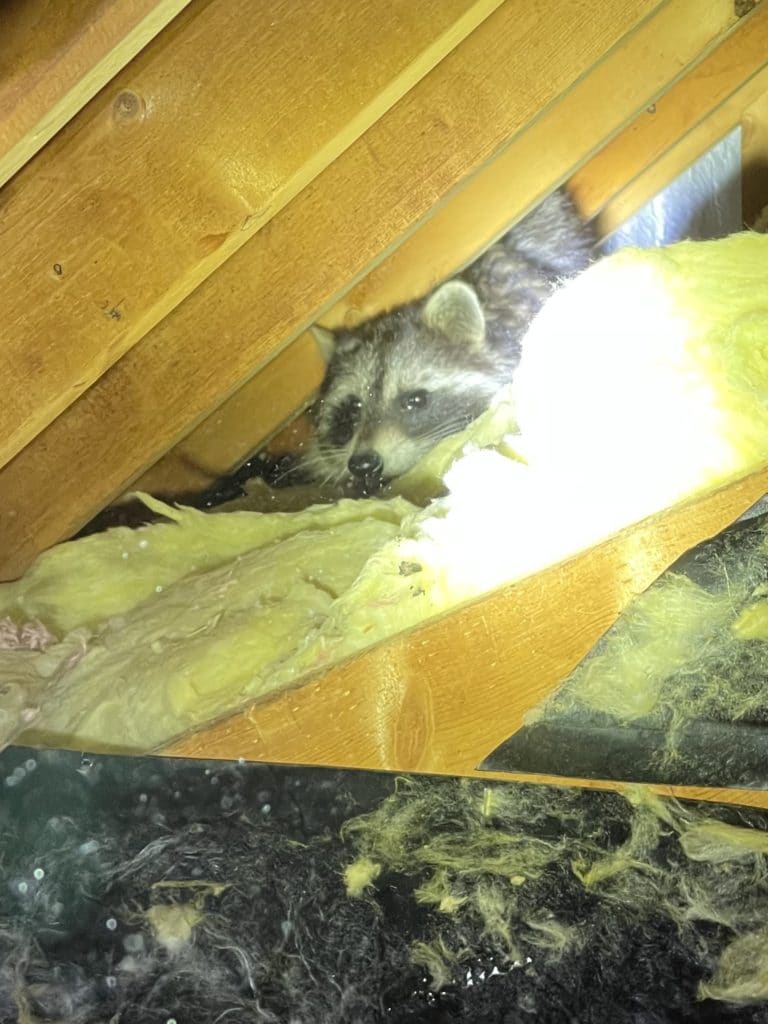The Do's and Don'ts of Legally and Humanely Trapping Raccoon.
Phase 1 Attic Inspection:
First you must make sure the noise in the attic is actually raccoon. An attic inspection will be necessary so one must prepare themselves. Attics are very dangerous places, with uncommon hazards everywhere. There can be disease carrying spores from raccoon feces, bat guano, black mold or asbestos fibers floating in the air. We first assess if anyone with a jeopardized immune system or small children will be around the attic hatch. Then we lay a drop cloth under the hatch opening in case feces, insulation or other bio-hazards might fall on when the hatch is opened.
After removing articles of clothing or covering them, we put on totally enclosed Tyvek suits and respirator. AT this time you might want to pull up a piece of plywood if you are not use to walking on ceiling joist covered with insulation. One wrong slip and you will push your foot right through the ceiling drywall. If this happens you will suffer a SUPER WEGGIE on the ceiling joist or possibly a broken leg. Either way you will have lost far more $ than a professional would have charged for raccoon eviction.
First we evaluate if asbestos insulation is present, if so, back out…you are done here, call a professional. If not, we look for any type of mold covered feces or guano. If found, be sure not to disturb it or move through it and carry mold spores back down inside the home. Moving on, keep your head low because roofing nails are poking out through the plywood every where above you. Also watch your step for construction debris and nails hidden in the insulation.
Closely examine ridge vents, roof vents, fan vents, wires, bathroom and kitchen, heating and AC vent hoses and ducts for coon damage. Many times fans or lights stop working for an unknown reason or insulation falls out a fan vent and people never associate the damage with the silent intruder above. Look for smashed down insulation and coon toilets. Coon tend to defecate in the same area over and over again many times soaking the insulation to the point where there’s a stain or wet spot (where paint peals) on a ceiling below.
Most of the time you will not see a raccoon, no matter how many are present. They hear you open the hatch and hide in the soffit or dormers. During mating and birthing season you may very well see the coon: proceed with caution because coon are lighting fast and will defend their mates and litters…with their life when cornered. If you are surprised or charged by a coon and bitten, THAT COON WILL HAVE TO BE EUTHINIZED (with out damaging the skull) and taken to the Health Dept. for rabies testing.
Now that your certain you have coon inside the attic, take pictures of all the damage if you intend on making an insurance claim. Descend the ladder and take your Tyvek suit off, inside out into an enclosed ball. Remove your respirator and vacuum up all debris fallen where you stand, without moving about. Dispose of the Tyvek suit safely and thoroughly clean your equipment and camera of potential dust and spore hazards clinging to them BEFORE ANY OTHER PERSON USES THE ITEMS.
Or contact Awesome Critter Gitters to schedule an attic inspection!
Trust the #1 Wildlife Removal & Animal Control Professionals
Contact us today to speak with a professional. We’ll safely and humanly remove wildlife from your home and keep them out for good. Trust us, the Wildlife Removal experts with over 50 years of experience!
800-934-7454
The Do’s and Don’ts of Legally and Humanely trapping Raccoon out of an attic yourself.
Phase 1 Attic Inspection:
First you must make sure the noise in the attic is actually raccoon. An attic inspection will be necessary so one must prepare themselves. Attics are very dangerous places, with uncommon hazards everywhere. There can be disease carrying spores from raccoon feces, bat guano, black mold or asbestos fibers floating in the air. We first assess if anyone with a jeopardized immune system or small children will be around the attic hatch. Then we lay a drop cloth under the hatch opening in case feces, insulation or other bio-hazards might fall on when the hatch is opened.
After removing articles of clothing or covering them, we put on totally enclosed Tyvek suits and respirator. AT this time you might want to pull up a piece of plywood if you are not use to walking on ceiling joist covered with insulation. One wrong slip and you will push your foot right through the ceiling drywall. If this happens you will suffer a SUPER WEGGIE on the ceiling joist or possibly a broken leg. Either way you will have lost far more $ than a professional would have charged for raccoon eviction.
First we evaluate if asbestos insulation is present, if so, back out…you are done here, call a professional. If not, we look for any type of mold covered feces or guano. If found, be sure not to disturb it or move through it and carry mold spores back down inside the home. Moving on, keep your head low because roofing nails are poking out through the plywood every where above you. Also watch your step for construction debris and nails hidden in the insulation.
Closely examine ridge vents, roof vents, fan vents, wires, bathroom and kitchen, heating and AC vent hoses and ducts for coon damage. Many times fans or lights stop working for an unknown reason or insulation falls out a fan vent and people never associate the damage with the silent intruder above. Look for smashed down insulation and coon toilets. Coon tend to defecate in the same area over and over again many times soaking the insulation to the point where there’s a stain or wet spot (where paint peals) on a ceiling below.
Most of the time you will not see a raccoon, no matter how many are present. They hear you open the hatch and hide in the soffit or dormers. During mating and birthing season you may very well see the coon: proceed with caution because coon are lighting fast and will defend their mates and litters…with their life when cornered. If you are surprised or charged by a coon and bitten, THAT COON WILL HAVE TO BE EUTHINIZED (with out damaging the skull) and taken to the Health Dept. for rabies testing.
Now that your certain you have coon inside the attic, take pictures of all the damage if you intend on making an insurance claim. Descend the ladder and take your Tyvek suit off, inside out into an enclosed ball. Remove your respirator and vacuum up all debris fallen where you stand, without moving about. Dispose of the Tyvek suit safely and thoroughly clean your equipment and camera of potential dust and spore hazards clinging to them BEFORE ANY OTHER PERSON USES THE ITEMS.
Or contact Awesome Critter Gitters to schedule an attic inspection!
Trust the #1 Wildlife Removal & Animal Control Professionals
Contact us today to speak with a professional. We’ll safely and humanly remove wildlife from your home and keep them out for good. Trust us, the Wildlife Removal experts with over 50 years of experience!
800-934-7454

